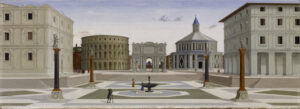Name: Sam Lynch, Assoc. AIA
CivicLAB Class: 2019
Alma Mater: Savannah College of Art and Design
Hometown: Davidsonville, MD
Why was it important for you to take part in CivicLAB?
We’re all idealists, right? That’s why we chose Architecture and how we survived the all-nighters and stress of critiques. A lot of times that feeling seems to get lost early in this profession because there is just so much we still must learn, and the tasks required are sometimes mundane compared to the possibilities of studio. Like a lot of my peers, I wanted to feel like all that work was not for naught and that I could contribute something meaningful to my community. I had recently gotten involved with the Urban Design Committee and had an opportunity to succeed one of the Co-Chairs. I couldn’t pass up that opportunity but simultaneously felt woefully unprepared. CivicLAB seemed like the perfect crash course to quickly develop the skills needed to engage with those already doing the work and continue to build on what the Urban Design Committee could do.
Since Participating in CivicLAB what new leadership opportunities have you discovered?
To be completely honest I’ve actually had to do a bit of paring back. As I mentioned I took over as one of the two Co-Chairs of the Urban Design Committee right around the time I participated in CivicLAB. I had also gotten heavily involved with my neighborhood association and a few other civic and transit-oriented groups here in the city. I pretty quickly learned that I’m personally more productive doing a few things well than a lot of things, not so well. Still, not being one to say no to much of anything I jumped at the opportunity to join the AIA Baltimore Board of Directors as Associate Director this past year. Beyond that it’s been a lot of little things plugging in where I can be useful.
How can architects/designers become better advocates for the profession and the built environment?
Ride a bike. Take public transit or just try walking somewhere. I can promise you the world (and specifically our city) is a very different place without the luxury of a car. We must get out of our bubble sometimes if we’re going to better understand who we’re designing for. Volunteer for a review board or your neighborhood association. Talk to your neighbors about their concerns. You’ll be surprised how many of them are at least indirectly influenced by the built environment. Read about the issues that interest you and seek out the groups that are already leading in those spaces. Sometimes in advocacy spaces we waste too much effort reinventing the wheel when we just need to find a way to help those already doing the work. I absolutely love the energy of new advocates and activists but sometimes my best advice to leaders, including myself, is to shut up and listen.
What makes this an exciting time to be a Citizen Architect in Baltimore?
These are truly radical times we live in. Whether it’s our socio-economic bubble or groupthink amongst our peers we tend to consider our immediate conditions as “normal” or some kind of neutral position. I can promise you the past few years have not been normal and there is an incredible opportunity to create a better world in lieu of “returning to normal.” Who would have thought that we’d be reconsidering what an office is and where “work” happens? Reclaiming street parking as public space or outdoor dining was once unthinkable but now, we have real world data on how successful it can be. The murders of Breonna Taylor, George Floyd, and so many others have renewed and mainstreamed calls for racial justice beyond just policing but including the reversal of redlining, disinvestment, and other forms of segregation in our built environment. The recent infrastructure bill passed through Congress has created the opportunity to finally secure funding to remove the Highway to Nowhere and begin to repair those communities. The residents of Poppleton are fighting tooth and nail to save their homes and community from the continued use of eminent domain. There are so many issues both nationally and right here in Baltimore that are desperately calling out for Citizen Architects both as leaders and allies. A better world is possible.
Any hobbies outside of leadership, advocacy, and architecture?
I love reading. The majority of what I read is non-fiction and so there is a little overlap with the categories above. I love history, urban planning and transit, and anything public policy related. Unions and the history of organized labor is big on my reading list for 2022. I think it’s really important to understand why things are the way they are. So much of what we consider to be givens or out of our control are actually just policy decisions. Astronomy and more theoretical physics like quantum mechanics and string theory are really interesting to me even if I’ll never fully understand it. It’s a great reminder of how much we don’t know. That also leads me into Sci-Fi if I want to dabble into fiction. When I want to dial back the nerdiness a bit my fiancé and I love to hike and camp. We hope to do some backpacking when her doctorate program is finished next year. Probably our favorite low-key thing to do is just explore the city. Even after six or so years of living here there is always something new to discover on foot or biking through different parts of the city.


